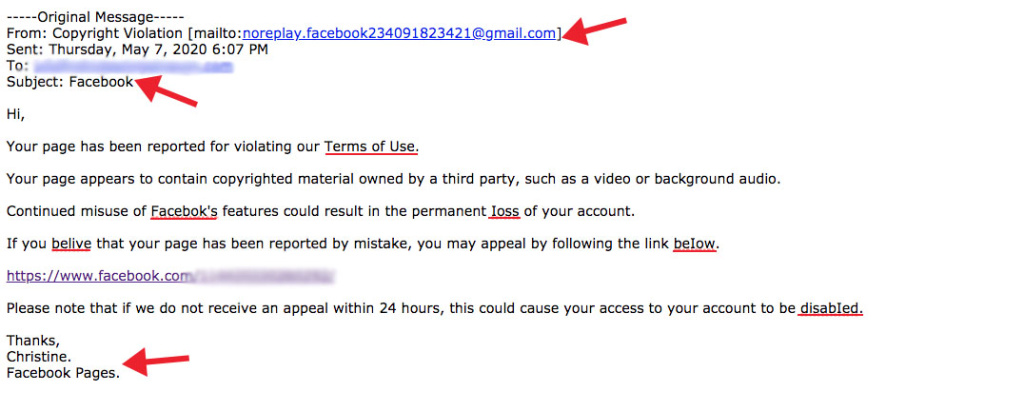It’s a four-letter word with a negative connotation (no, not THAT one). Spam—and we’re not talking about the canned meat. Anyone with an email address knows that try as you might, it’s impossible to keep solicitors out of your inbox. Like it or not, spam happens. However, recognizing a scam email can make the difference between simply deleting the wayward message or getting taken advantage of—and potentially having your identifying information compromised. Here, we’ll point out a few tell-tale signs for spotting a scam email.

An email address that seems fishy
If the email address is completely unrecognizable, that’s your first clue for spotting a scam email. You should be able to easily identify a person’s name or the company they claim to be representing. Still then, some scammers will try to fool you with addresses that come from “facebook123@gmail.com” (see our example above). Let’s think about it for a second. A company like Facebook would never send an “official” message from @gmail.com. It would be from their own server, @facebook.com or a subsidiary of such.
Misspelled words/grammar mistakes
Any official correspondence should not be riddled with misspelled words and grammar errors—especially from a company like Facebook, (using our example). Check all parts of the email for copy mistakes like these, including the email address, subject line, body copy and email signature. We have underlined all of the misspellings in our example in red.
A subject line that looks sketchy
Speaking of subject lines—clue in to that first before you dive into the email itself. In our example, this subject line read “RE: FW: Facebook” when it appeared in our client’s inbox. It’s messy, sketchy and it is spam. Again, look for misspelled words, grammar mistakes or signs that the email has already been replied to or forwarded.
A faulty sender’s signature
In our example, the signature comes from “Christine.” at “Facebook Pages.” You would think that someone reaching out to Facebook users from Facebook would have a bit more of a legitimate-looking email signature, and you’d be correct. Check this area of the message for errors, strange wording, lack of contact information, etc.
Context errors
A sign of a scam email is that the sender is not relaying accurate information from the perspective of who he or she claims to be. For example, in our screenshot, the scammer refers to Facebook’s “Terms of Use.” However, a quick Google search shows us that Facebook refers to its policies as “Terms of Service.”
Outrageous claims or promises
Now for the most important factor in spotting a scam email—examining what the content is relaying or requesting. What is the sender asking you to do? What is the sender claiming has happened? Typically, scammers make outrageous claims or promises in order to have you turn over critical information that can aid them in whatever nefarious motives they have. Basically, no African Prince will ever really just send you $10,000 in exchange for your bank information.
In addition to outrageous claims, look for threats. The type of language scammers often use claims that “if you don’t do (insert request here), bad things will happen.” In our example, we can reference the line “If we do not receive an appeal within 24 hours, this could cause your access to your account to be disabled.” Don’t believe it unless you can verify it with a trusted party.
It just feels wrong
When it comes to someone trying to best you, don’t ignore your intuition. Most of the time when people read scam emails, something just seems off. If you are questioning it, this is often enough to tell you that it probably deserves to be looked into.
Best practices for dealing with scam emails
Spotting scam emails is one thing, but what next? First and foremost, if you suspect spam, do not click any links in the email or open any attachments—even if it says it’s an invoice. If you hover over links in the email, it will show you what web address the link actually goes to despite what the text of the link reads.
If it’s obvious that an email is not legitimate, the best and easiest thing to do is just delete it and move on, but if you are unsure—consult an expert. We are happy to help our clients identify scam messaging in their inboxes when something seems amiss.
Fortunately, the majority of today’s email programs contain a spam filtering option, so the bulk of the bad never actually makes it in front of you. This can backfire at times, when a legitimate message is accidentally routed to the spam folder.
Summary
Learning best practices for identifying and avoiding scam emails is an important way to help us all become better online citizens. The consequences of falling for an online scam can be severe, so it is critical that we know how to distinguish what’s genuine and what’s garbage.
McNutt & Partners is a full-service advertising and digital marketing agency. Contact us today for your marketing needs! Call 334-521-1010, or visit our contact page.

